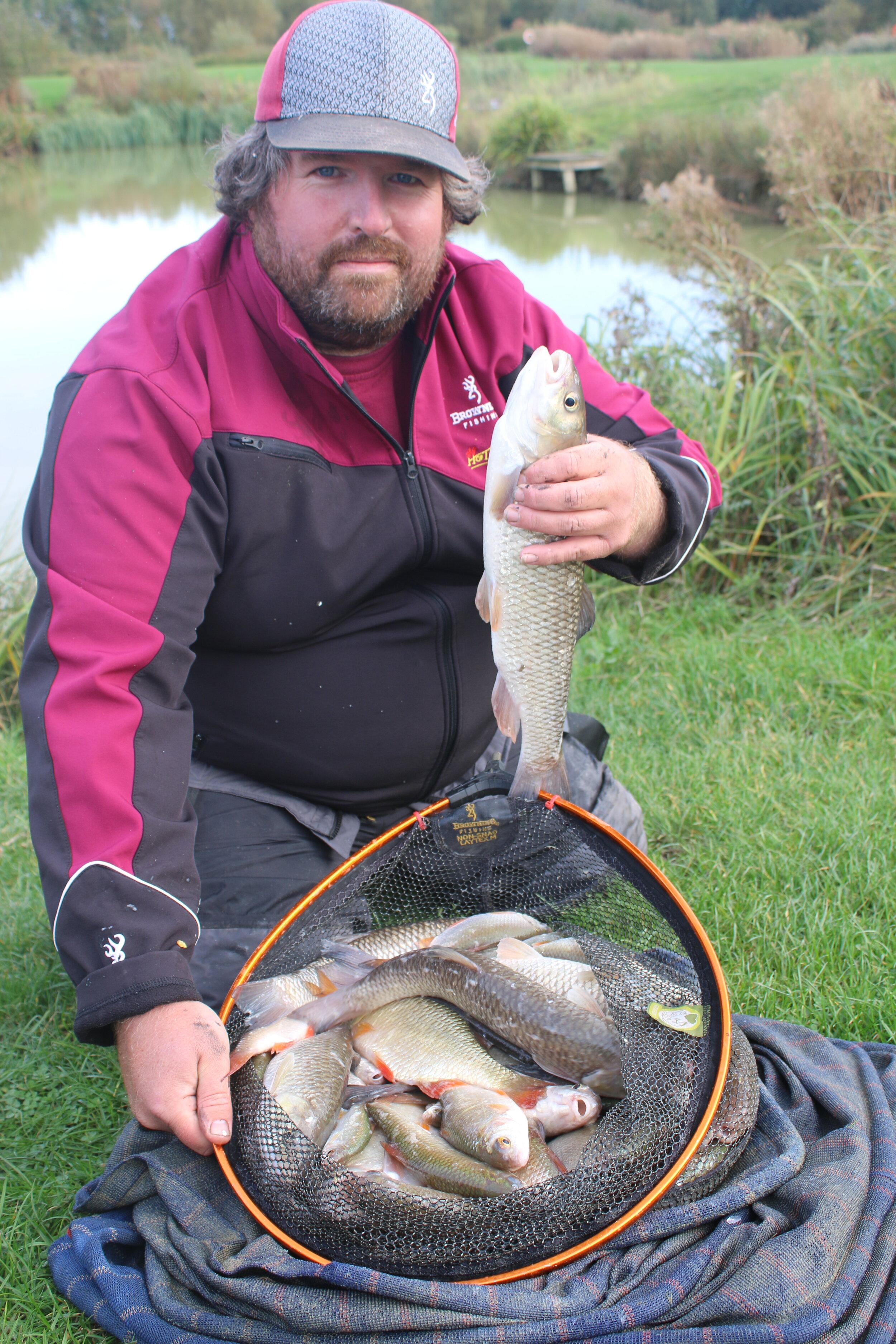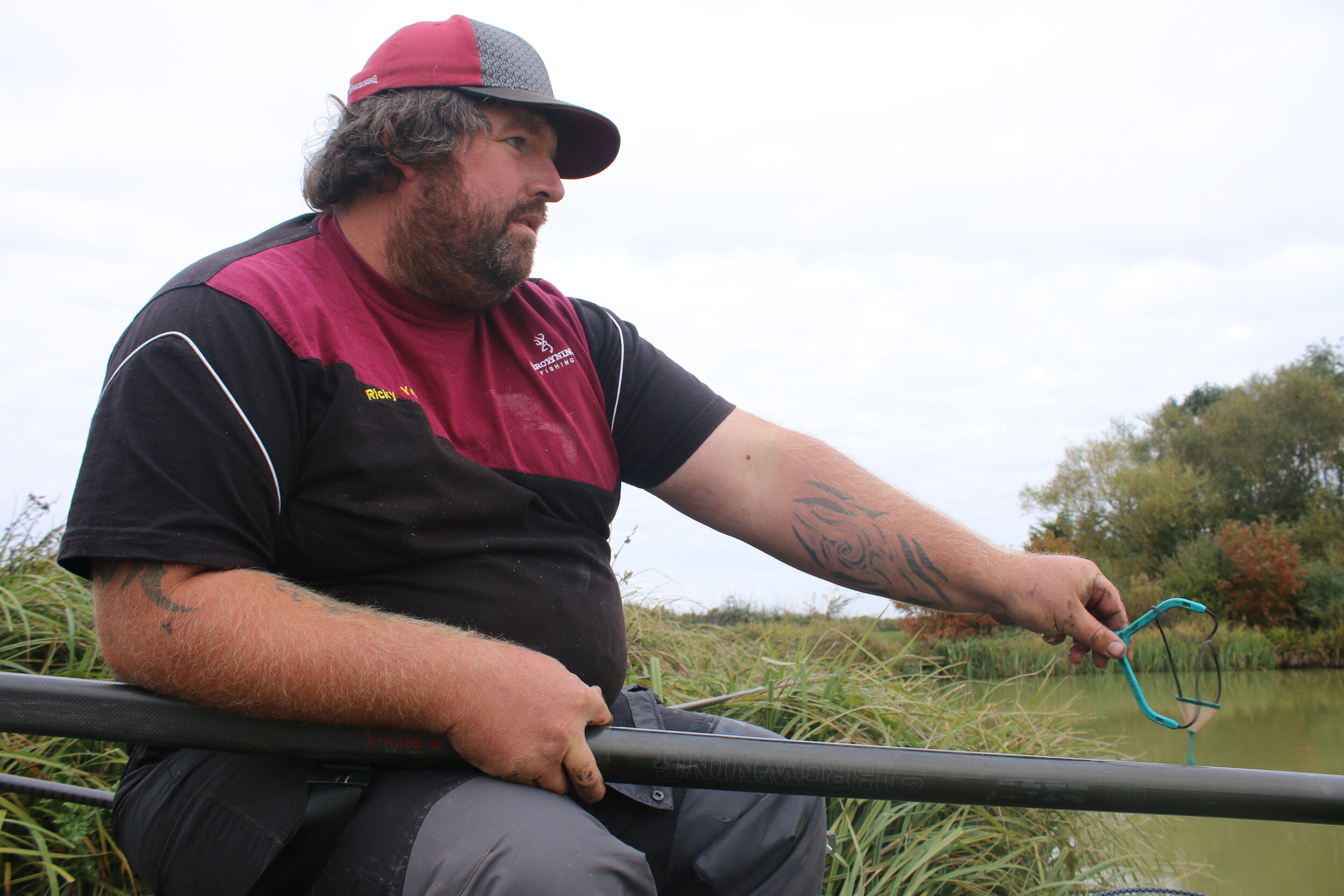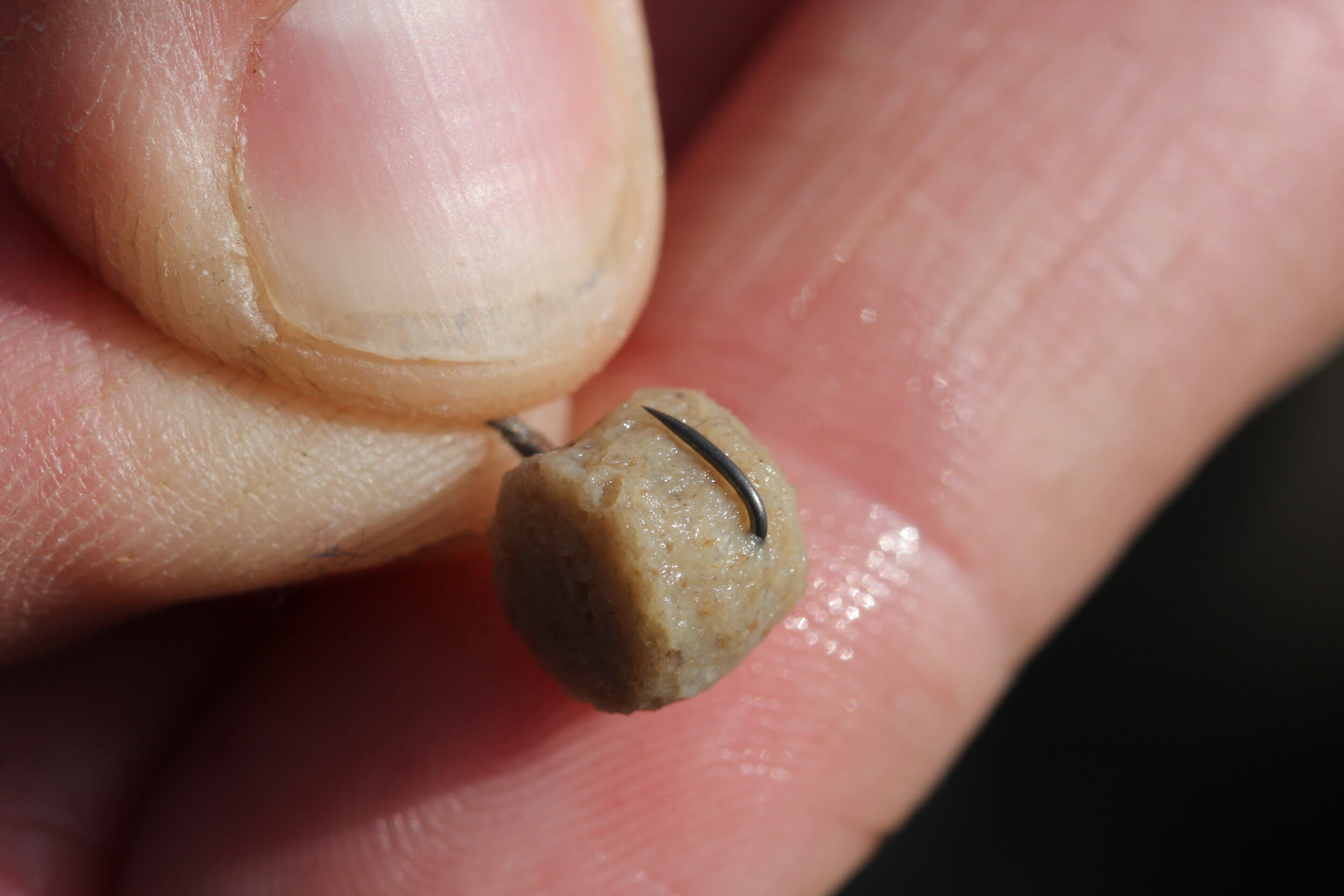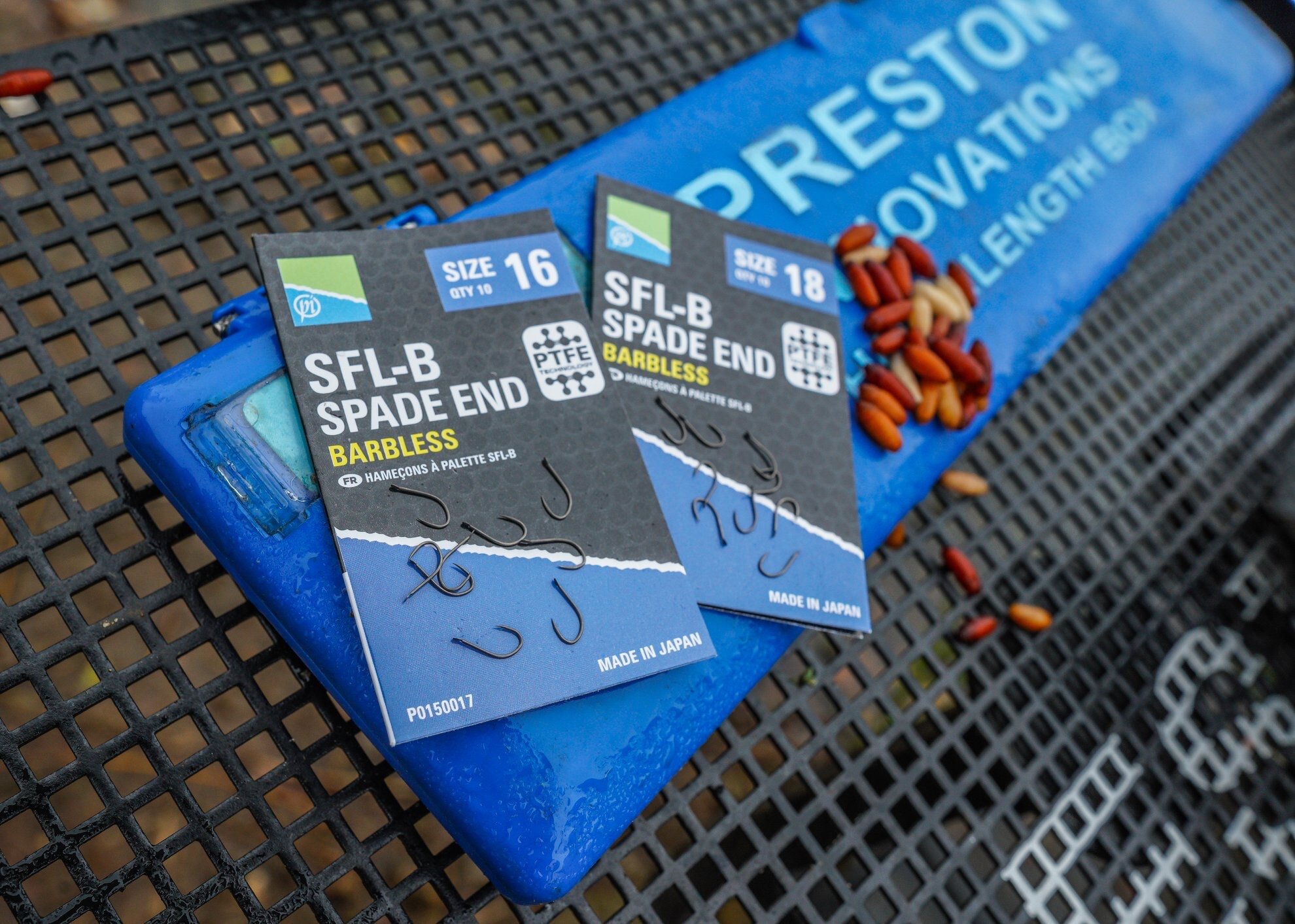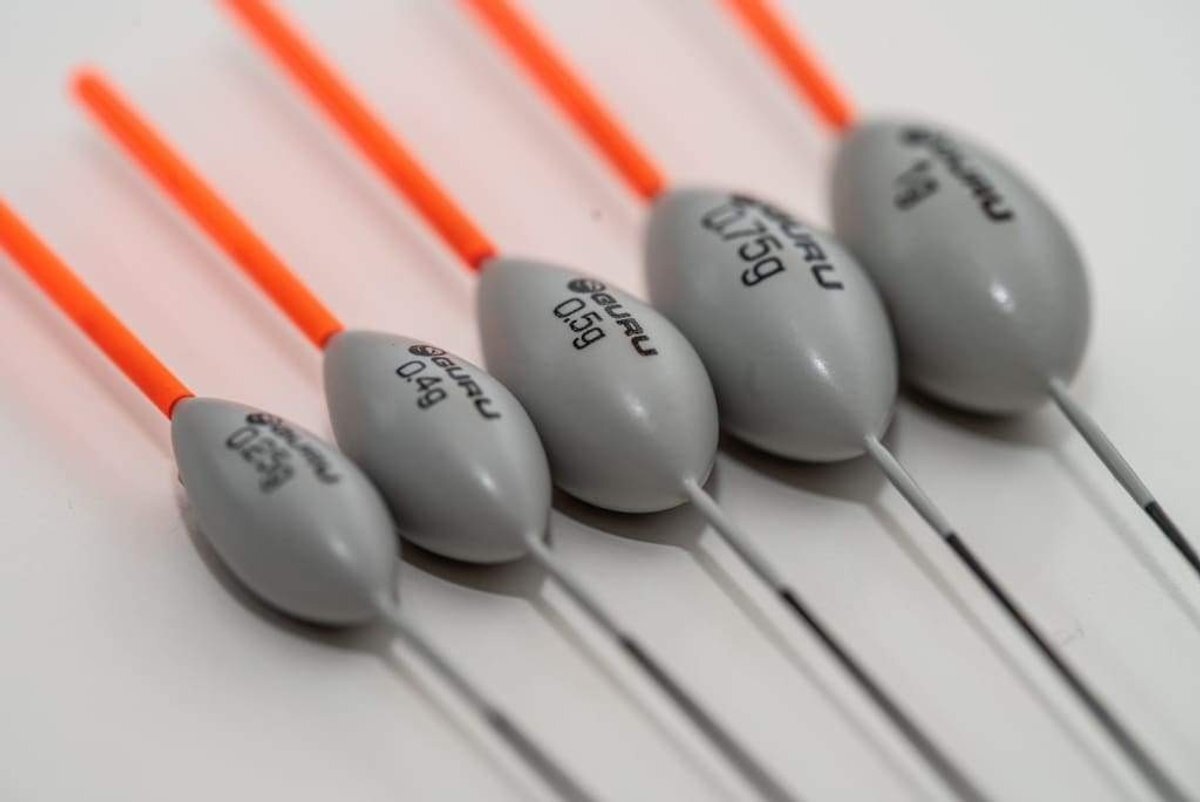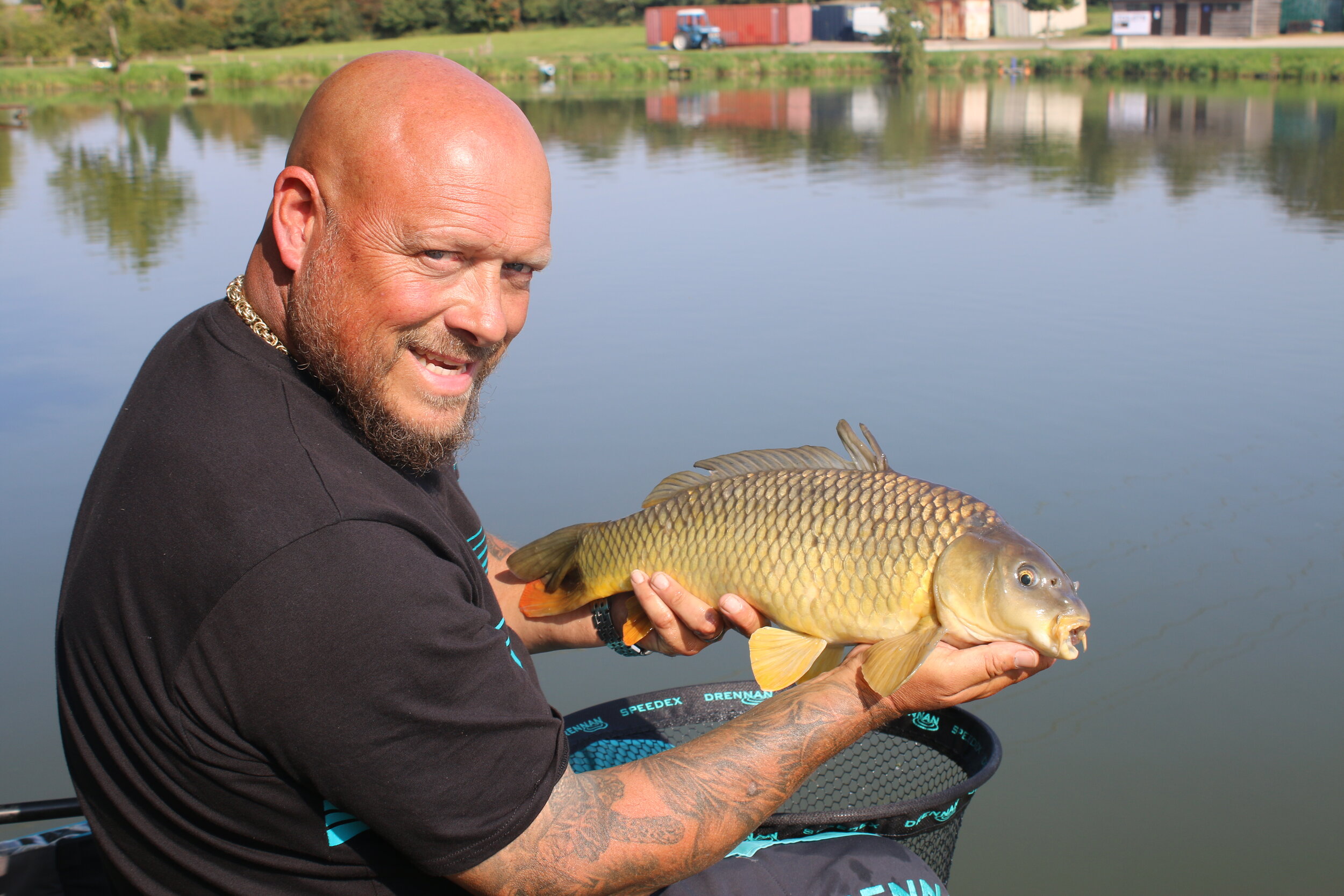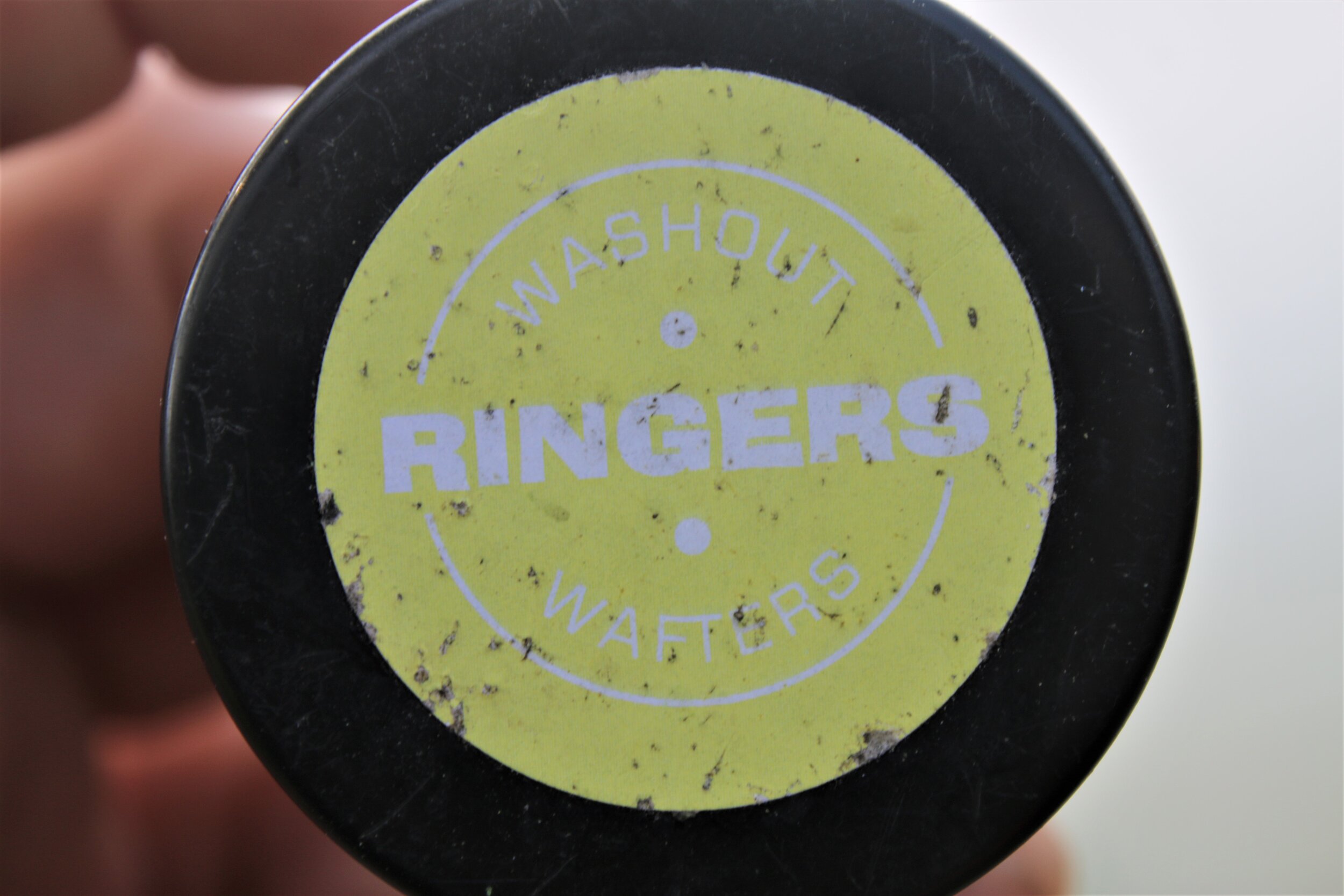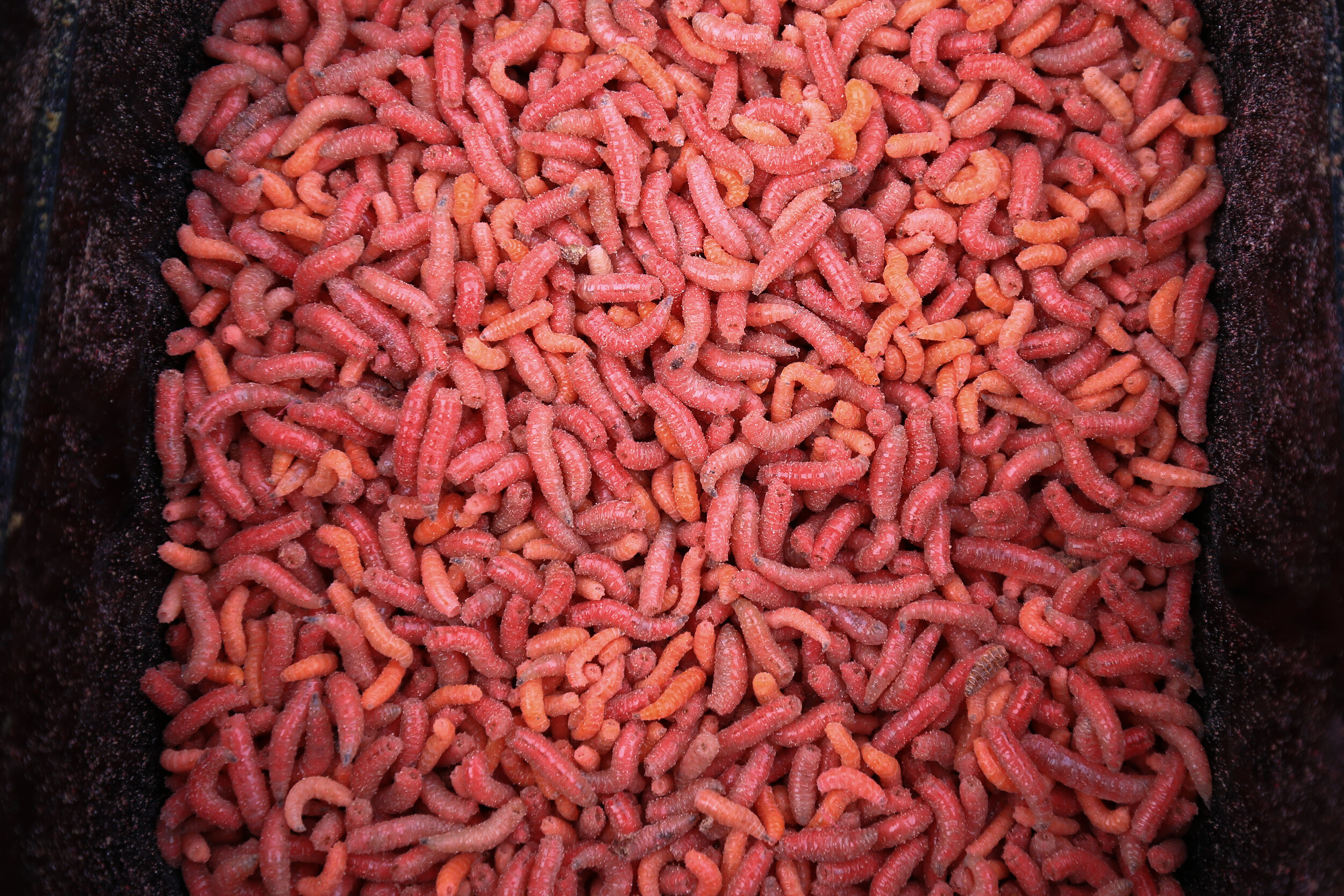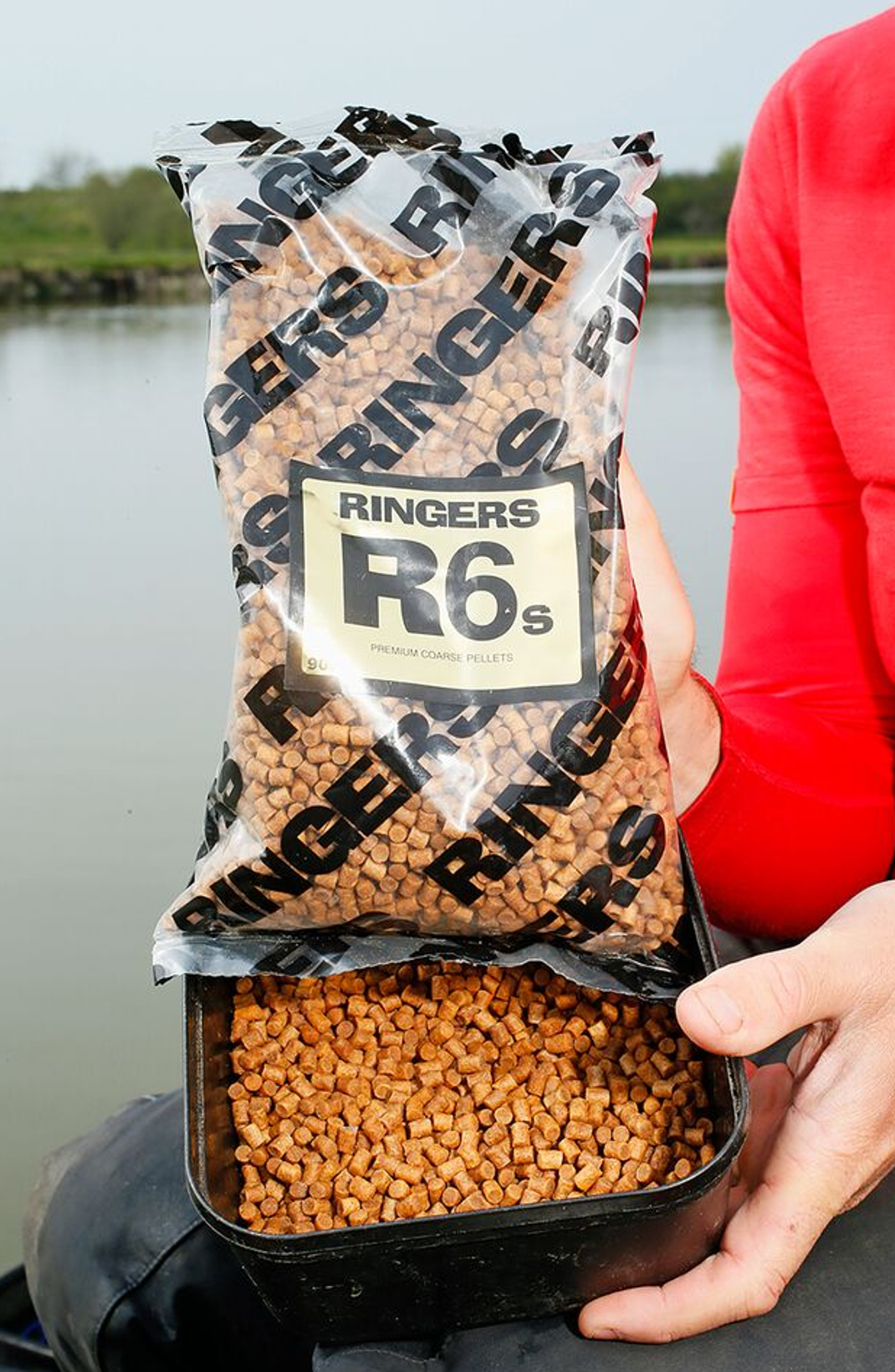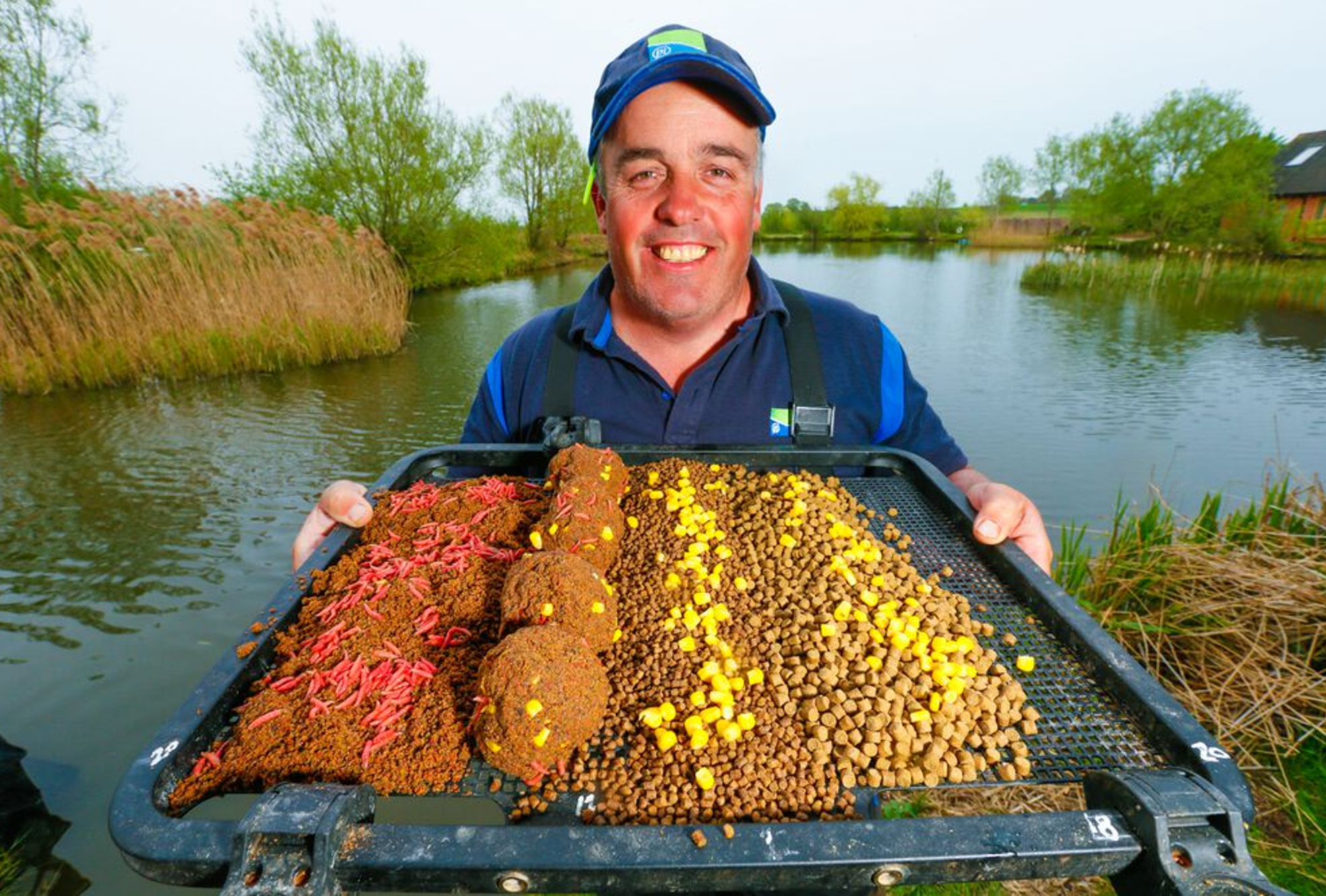Commercial Fishing Tips | Six tips to shallow up for silvers - Ricky Young
As long as the temperatures overnight and in the day stay settled, with no big drops, I’ll put my money on catching a big net of quality silvers by fishing off bottom, sometimes even properly shallow.
Fishing shallow can catch you quality nets of silvers
Here’s some tips to help you do the same…
GO FOR A LIGHT ELASTIC
Even if you hook a rogue carp, you can get it out using light elastic. The Browning Microbore orange grade I use is perfect – soft enough to land roach and skimmers without hook-pulls, but you can land a carp with a side-puller kit.
Big fish can be landed on light elastics
GREAT PRESENTATION
A light float allows the bait to fall through the water slowly and find the bigger roach. A homemade slim-bodied 0.2g float taking seven or eight No10 shot strung in the bottom half of the rig will get the job done.
A light float encourages a slow fall of the hookbait through the water
USE GROUNDBAIT
I’ll pot in three large balls of groundbait. This attracts and focuses the fish in a spot over which I can then fire casters. My mix is a split of Browning Black Roach, Quick Skimmer and Formula Fish.
Pot in groundbait to draw the fish in from the off
SWITCH TO MAGGOTS
Casters are always my choice for silverfish, but they can sometimes be too selective. Maggots are the great fall-back bait that can get a peg going again when it seems to have slowed up.
Maggots are a great change bait if bites slow down on casters
FEED A SECOND LINE
You won’t plunder one line all day, as the fish will eventually back off. This is where I have a second swim on the go, to target big roach and skimmers. I put this in at 6m but off to one side, and will only fish here on the bottom.
Feed another line to with to when bites slow up
FEED WITH A CATTY
While the weather remains mild, the fish will still be active. To catch off bottom, you need to keep loosefeeding casters. The regime is 10 casters fired in every time I drop the rig in and every 60 seconds when I’m fishing the close-in line.
Keep the feed going in
Commercial Fishing Tips | Catch more silvers on chopped worm - Steve Ringer
ALTHOUGH I think we’re past the window in the year when chopped worm works for big carp, where silverfish are concerned it’s still a vital bait to have to hand.
We all know perch love worms, but so do roach and skimmers. If I was fishing a venue with a real mix of fish in it, such as Lambsdown Lake at Meadowlands Fishery, worms would always play a part – not however, when fed on their own!
Instead, I try to combine worm with groundbait and other goodies like casters and dead pinkies. Few people can deny the pulling power of chopped worms. The juices that leak off pull fish in quickly, but this is a feed that you need to go steady with.
Feed too much and worms in cold water can put the fish off. By introducing only a small taster of finely-chopped dendra worms every time I feed on the pole, or cast a feeder, I’m in a position to work out how well the fish are responding, allowing me to increase or decrease the amount of feed.
Chopped worm is a vital bait for silvers in the colder months
RIDDLE OFF THE SOIL
I want worms soil-free. I’ll riddle off the bulk of the soil and then pop them in a tub. The worms will ball up, pushing off excess soil.
Riddle excess soil off your worms
MAKE A MUSH
How finely you chop worms is dictated by the size of fish I’m after. Big fish need a rough chop, but smaller fish need a minced-up mush.
For smaller silvers, try to create a worm mince
START WITH A PINCH
Bream love worms, but sometimes not in the cold. I’d start with just a pinch of choppie inside a ball of groundbait or in the feeder.
Just a pinch is enough to add attraction to groundbait
CHOP SOME CORN
I’m a big fan of the colour yellow for bream, so I’ll chop up some corn to add to the mix. This puts small flecks of colour into the swim.
Corn and worm is a deadly combination
Commercial Fishing Tips | Six tips to get the most out of soft pellets - Lee Kerry
It's time to make the seasonal switch to soft pellets! Here are six tips to get the most out of them…
SOAK THE FEED PELLETS
My No1 cold water feed pellet is a soaked 2mm. Referred to as micros, I soak mine heavily, submerging them in a Pellet Wetter for three to four minutes so they dissolve as the fish eat them.
2mm micros are a perfect winter feed
MIX UP HOOKBAIT SIZES
You can’t beat an expander pellet on the hook. A 4mm bait is the optimum size, but I have a mix of 3mm, 4mm and 6mm expanders on the go and change them depending on the size of fish I’m catching.
Carry a mix of expanders
HOOKING EXPANDERS
I like to thread the hook fully through the pellet, getting as much hook into the bait as possible. This makes it less likely that the hook will pull out of the bait when you strike or lift and drop the rig.
Try to get as much hook into the bait as possible
THE RIGHT RIGS
When fishing pellets, you need complete control of your bait. I use a maximum of a 4ins hooklength so that as soon as a fish picks up the bait, the bite registers on the float, even if the indication is tiny.
You need the bite to register on the float as soon as the fish picks up the bait
BALANCE YOUR KIT
The lighter the hooklength you use, the more bites you’ll get. I love the Preston Innovations 9h Hollo elastic, with a stiff mainline such as 0.18mm Accu Power, but hooklengths down to 0.10mm if required.
The lighter hooklink you use, the more bites you will get
THEY MIGHT NOT WORK!
Sometimes soft pellets won’t catch that well. If you’re on a difficult water, then soft pellets are a good choice. However, if you are getting lots of fish you don’t want to target, go for a hard pellet or corn.
If you are getting lots of bites from small fish, try switching to hard pellets or corn
Commercial Fishing Tips| Six steps to November success with Tommy Pickering
WATCH THE CLOCK
I always keep an eye on my watch but timings aren’t set in stone. I’ll want to catch on the feeder and long pole for the first half of a session then, with three hours to go, move to the 6m line and then the margins.
Start long and come short
FEEDER OR BOMB?
I’ll always begin on a small Hybrid feeder with micros cast to an island, to a distance where I can loosefeed pellets comfortably. If the feeder is slow I can then change to a bomb, and still feed the swim.
If the feeder is slow, switch to the bomb
DROP FEEDER SHORT
A Method feeder on the short pole line can be deadly when the lake is towing hard or if I’m getting liners from fish coming off the bottom. The rod you’ve used to cast to an island or open water will do nicely.
Don’t be afraid to drop the feeder short
ALWAYS USE A POT
Once I drop a rig in, I change from hand feeding to a small pole pot. This way I can line the fish up where I want them. Normally I’ll be feeding 4mm pellets, but micros also work if the peg is shallow.
Deliver feed with a pole pot
BRIGHT HOOKBAITS
If I’m not catching well, my first action is to change to a bright hookbait. Fjuka Neeonz are brilliant and I’ll use yellow or white for clearer water, pink or orange for coloured lakes.
Bright hookbaits will buy you extra bites
ACCURATE FEEDING
For accurate grouping, cup your hand with the feed almost on your fingertips. This way there’s no spread of bait – do it with a more open hand and it’ll go everywhere!
Accurate feeding is vital
Commercial Fishing Tips | Catch a big weight of perch with Steve Ringer
Over the last few years, one fish that’s really come to the fore on commercial fisheries up and down the country is the perch.
And I’m not talking about just catching the odd one either because weights in excess of 50lb of perch have been caught on some waters. That’s exceptional fishing in anyone’s book. In fact, big perch have become so important on some lakes that they have acquired their own nickname of MVPs (most valuable perch)!
That’s certainly true in matches when the carp aren’t really feeding and five or six big perch for 10lb-plus can make a big difference at the final whistle, but for pleasure fishing, I think targeting perch can be even more rewarding.
They grow to quite a fair size and can be caught on relatively simple tactics too, so there’s no need for you to break out the specimen-hunting gear to have the chance of netting a 2lb-plus fish!
When the carp aren’t really feeding, five or six big perch for 10lb-plus can make a big difference
Fish the margins
The best place to target perch on commercials is in the margins. They love to patrol the edges, and if your margins have a feature such as an overhanging tree, that’s even better. You want to be fishing in 3ft of water to catch large numbers of perch. In fact, the deeper the edge is, the better it will be.
The best place to target perch on commercials is in the margins
Top perch baits
Worms are a good bait for perch, but once the water temperature drops, maggots and casters are better. Double maggot is a decent-sized hookbait, and when the water is clear fishing one white and one red maggot makes a huge difference. The white maggot definitely gets you more bites.
Double maggot is a decent-sized hookbait
Strike hard!
Big perch have very hard, bony mouths. Setting the hook when perch fishing is key, so I use a slightly heavier elastic, Orange Hydro. You need to strike firmly – a gentle lift won’t cut it! You also need to be patient when the float goes under. Try and wait that extra second before striking.
Setting the hook when perch fishing is key
Feeding tips
Little and often is usually best, but I’ll try and give the fish an hour to settle. Starting feed is 10 to 15 maggots or casters every 90 seconds or so, which I then adjust accordingly once I’ve made the switch. If there are lots of small perch, I’ll up the amount I’m feeding to draw in some bigger ones.
Up the amount of feed to draw in some bigger ones
Commercial Fishing Tips | Time to get the most from natural baits - Ian Chadburn
In an age of pellets, paste and wafters on commercials, it’s easy to leave good old maggots and casters in the tackle shop fridges for the river and canal anglers. After all, maggots only attract little fish – and who wants to catch those?
As we start to experience colder weather, the answer to this question should be ‘everyone’. We can all recall days out when the carp haven’t played ball and you come off the bank with little to show for your efforts using baits like pellets.
Natural baits will still catch plenty of carp
As the weather and water cool, fish don’t feed as strongly or for long periods of time. This means you’re left with long gaps between bites, gaps that can easily be filled by adopting a natural bait approach with maggots and casters.
There’s not a fish swimming that won’t eat maggots, so you can never be sure what you’re going to hook when the float goes under. The natural route shouldn’t be limited to just maggots and casters either – worms and hemp also work.
Slow periods can be made busy with natural baits
Use groundbait
Keep one line reserved for big fish, feeding it with groundbait and corn. Depending on the depth, feed the groundbait either loose in shallow water with a silty bottom, or as a ball in deeper pegs with a hard bottom.
Groundbait should be fed on the big fish line
Catch them all
While you let the big-fish lines settle, fish for bites with maggots. These could be from a 2oz roach to a 10lb carp just 5m or 6m out. Throwing in around half-a-dozen maggots every drop-in will keep a steady stream of bait going in.
Keep feeding maggots in close to keep action coming
Little & large floats
On the maggot line, a slim float taking around 0.4g will let you fish with the bait falling through the water. On the long pole, big-fish agenda, this is upped to a 0.6g rugby ball-shaped pattern for stability.
Have several rigs ready
The baits to use
All you need are maggots, casters, worms, hemp and corn. Maggots, casters and worms are the main hookbaits, hemp and corn coming into play as feed. A couple of pints of each will be ample.
A selection of natural baits
Fish the margins
Until the first frosts strike, the margins are a great place to catch later in the day. Forget about finding 12ins of water... 2ft 6ins-3ft is what you’re after. Depth is more crucial than cover from reeds and lily pads.
The margins will still produce until the first frosts
Use your time wisely
Treat the big-fish lines as somewhere to have a look at now and then. The maggot line will be where you should spend most of your time. A maximum of 10 minutes is all you need on the big-fish lines.
Don’t spend too long waiting for bites on the big fish line
Commercial Fishing Tips | Sort your shotting with Steve Ringer
Shotting patterns – now there’s a topic you could argue about long into the night! What’s best for deep-water bream? What about the margins, or fishing up to an island?
I get asked questions about this a lot and it’s always hard to answer because the key lies in responding and altering your shotting to how the fish are feeding.
Some days, a straight bulk and two droppers pattern will be best while on others, spreading the shot out for a slower fall catches more. There’s no right and wrong answer and my biggest bit of advice would be to experiment. If you’re not catching as well as you’d like, slide the shot about to see if it makes a difference!
That said, for much of my fishing, whether on a commercial carp fishery or an Irish lough, I have two patterns that have served me well for years – the strung bulk and the straight bulk. I love using a strung bulk due to its versatility, as it allows me to change from quite a positive way of presenting the bait to a more refined one simply by moving the shots further apart.
The key lies in responding and altering your shotting to how the fish are feeding
Tailor your weights
For floats of 1g and upwards, use an olivette and below this, shot. A 0.8g float may seem to need too many shot and risk tangles, but that won’t happen if you use bigger-sized shot.
For floats of 1g and upwards, use an olivette
Shot sizes to use
When using rigs of 0.6g to 0.8g I’ll use No8 and No9 shot. For rigs below 0.6g I’ll use No10 and occasionally No9s. Lighter floats let you present the bait falling more slowly through the water.
Carry a variety of shot with you
Versatile pattern
I rate a strung bulk pattern. This consists of shot spaced 1ins apart in the bottom half of the rig. I space the shots further apart for a slower fall of the bait or create a bulk if I need it to get down quickly.
Strung shotting aids a slow fall of the hookbait
A solid bulk
Solid bulks tend to be an olivette for bream rigs, and are fished with two or three dropper shot below it. If I’ve got only shot on the line, I’ll group it together for fishing in the margins.
A bulk will help get the bait down quick for species like bream
Commercial Fishing Tips | How to hit more bites from F1s - Reece Hearn
I catch a lot of F1s in the cooler weather just as the bait settles, and in clear water I think that the fish actually watch the bait fall, so how you present the hookbait will go a long way to deciding many you actually hook.
I try to bomb the rig down towards the bottom as normal but then stop the fall with about 12ins of the rig sticking out of the water to let the rig straighten up.
I then slowly lower in the rest of the rig to give the bait a super-slow fall in the bottom foot of water.
I’ll also lift and drop the rig the same distance when fishing to keep the pellet falling in front of the fish. Try this and you’ll hit more bites!
F1s will watch the hookbait fall
Commercial Fishing Tips | Time to switch to corn - Steve Ringer
I’m sure we’ve all felt the chill in the air every morning, a sign that autumn is here and, with it, falling temperatures!
As far as fishing is concerned, this signals a changeover period from the methods and baits of summer to something a little more refined to ensure you keep on catching.
Water clarity will improve as colour begins to drop out of the water and fish, especially carp, will start to feed as much by sight as via their other senses.
With this in mind, hookbaits and feed need to be something that stands out, something that the fish can find quickly and easily. To my mind, there’s one bait that is king of them all – corn.
Super-soft and bright yellow, no fish can miss a few grains lying on the bottom and when all else fails, I know slipping a piece of corn on to the hook will give me a much better chance of a bite or two.
To my mind, there’s one bait that is king of them all – corn.
Big potting
How I feed depends on the species being targeted. If it’s a mixed lake, I’ll use a big pot to feed more, but if it’s just carp I’m after I’ll use a small one and feed for a single fish at a time.
If there are lots of species present, feed a big pot of corn
Hooking corn
As we move into autumn, I want to leave less and less, hook on show while leaving the hookpoint clear. I hook a grain through the rounded end so it will stay on the hook if I miss a bite.
Mask the hook as much as possible without covering the point
The right floats
Corn is a visual bait and fish will follow it down to the bottom. That makes using a float on the light side crucial iin order to give the corn a slow fall. The 0.4g Guru Wire Pinger is the ideal pattern.
A light float will aid the slow fall of the hookbait
Go for a light hook
To help with the slow fall of the bait, a light hook makes things look as natural as possible. The Guru Super LWG is my main corn hook, although a Kaizen is a good second choice.
Use a light hook too so the bait looks natural
Commercial Fishing Tips | Why meat is the bait at 6m - Grant Albutt
We’re just into autumn now and that means a little window of opportunity for meat to begin working on commercials. During summer, this bait takes a back seat to pellets, but when temperatures fall, there’s no better bait for carp, F1s, bream and skimmers.
Switch to meat when the temperatures fall to keep the carp coming
Whether you fish rod and line or the pole, meat works on them all, but there’s one particular part of a swim where fishing meat really gets results and that’s on the short pole line. Here are six tips on how to get the most from this deadly bait…
Hook meat correctly
Bury as much of the hook as possible, but leave a bit of hookpoint showing. My hook for meat fishing is the Drennan Wide Gape Carp in a size 14.
Bury as much of the hook in the meat as possible
Get your timing right
The final few hours are the time to fish meat short. Generally from around 1.30pm to 2pm is when I’d begin to concentrate fishing here.
Time when you will start fishing the meat
Work the rig
Working the rig always pays off with meat. To do this, I simply lift the float 6ins out of the water and lower it back in every minute or so.
Lift and drop is a tactic that works well with meat
Cube sizes
Using a meat cutter will save you lots of time and also ensure that each cube is of a uniform size. For a mixed bag, 6mm cubes are best.
Meat cutters
When colours work
I normally use plain-coloured meat, but coloured baits can have their day. Bream and skimmers love yellow baits and red can also get results.
Coloured meat can work very well for skimmers
Find the right line
The 6m line equates to around five sections of pole, but the actual distance is dependent on the depth. I’m looking for between 4ft and 6ft of water.
Look for 4-6ft of water to fish meat in
Commercial Fishing Tips | Get on the skimmers with Steve Ringer
AT this time of year, carp and F1s can be fickle creatures. Cooling water makes them less inclined to feed for long spells and, for the angler, that can mean a lot of wasted time spent waiting for a bite.
By changing your target species to skimmers, though, action is guaranteed. I know that they’re not everyone’s cup of tea, thanks to the slime they always leave behind on landing nets and clothing, but if they’re the right size, then skimmers are a great fish to spend those quiet spells of the session fishing for.
They grow big in commercials, thanks to a diet of pellets, meaning that catching 30lb of fish around the 1lb 8oz to 2lb mark is relatively simple. They also don’t need a specialised approach. When you’re fishing a commercial water the baits you use for carp will just as readily be taken by skimmers –namely corn and pellets.
Skimmers are a great fish to spend those quiet spells of the session fishing for
Catch close in
Skimmers like deeper water, and to catch them quickly you need to fish close in too. Look for so 5ft depth around 6m out. For the bigger fish you might have to go longer and deeper though.
Look for a depth of around 5ft for skimmers
Balls of pellets
Micros are the best feed on commercials, because the skimmers see so many. Instead of feeding them loose, where they can be spread out too much, feed a dampened ball of them.
A damp ball of pellets will keep the skimmers near your hookbait
Corn is king!
Although expander pellets would be my main hookbait, big skimmers love corn. I only use corn when trying for a better fish and will feed a few grains by hand to attract the bigger ones.
Skimmers love corn
Positive floats
You need a substantial float in deep water. The Guru Wire Pinger in 0.6g is very stable, allowing me to combat any wind or tow. I work the rig by lifting and dropping it to entice a bite.
Use a stable float in deep water
Commercial Fishing Tips | When to use which bait colour? - Steve Ringer
If you’re anything like me, you’ve got tubs full of hookbaits in a range of colours – but how many of them do you actually use?
Which colour hookbait to use is down to water clarity
Confidence in a hookbait plays a big part and it’s easy to keep picking out the same one, working on the assumption that you caught on it last time, so why would it be any different this time round? Nothing wrong with that, but bait companies make different-coloured wafters and hook pellets for a reason – they all have a time and place!
Which colour to use is down to water clarity. In coloured water, some colours can be seen better than others. On the flip side, gin-clear winter swims call for a different bait that stands out easily.
Take the Ringer Baits Chocolate Orange Wafter. This has caught me hundreds of carp and bream, but it won’t always be the one I go for. First I will find out what colour works best at the fishery I’m visiting. I’ve had too many sessions where a yellow bait outfishes all others.
I’ve broken the options down into my four main colour choices, but do experiment.
A bright green bait that’s been sat in a tub for months might just catch you one a chuck when nothing else is working!
Fluoro yellows & whites
These are the ones to go for in clear water or in winter. Yellow is especially good, as it’s the same colour as corn, another top clear-water bait.
Yellows and whites are a great clear-water bait
Fluoro pinks & oranges
These are best on heavily-coloured fisheries, mainly for the silhouette that they make. The shadow is easy for fish to pick up.
A flouro pink or orange is best in coloured water
Natural
Natural brown hookbaits work in summer when I’m feeding a lot of pellets. A plain hookbait ‘matches the hatch’ of my feed.
Dull browns work best in the summer months
Washed-out
These baits are very dulled down to look as if they’ve been in the water for ages. Washed-out yellow wafters are a real winter favourite.
Washed-out yellow is another winter winner
Commercial Fishing Tips | 5 tips for maggot feeder fishing
Once the sole preserve of river anglers chasing chub, the maggot feeder has now made its mark on commercial fisheries too – and not just for carp!
Here are 5 tips to make the most of the method…
Mix up the freebies
It’s common to feed a mix of baits when fishing the pole, so why can’t you do the same with the maggot feeder? Alongside maggots, add some fluoro pinkies and even a few casters or fish something a bit different. This also provides you with an alternative hookbait option if you’re struggling for a bite. Double maggot is the best starting bait, but switch to three pinkies from time to time to see if it improves the fishing.
A mix of maggots and pinkies can help keep the bites coming in thought conditions
Pack the feeder
Maggots will soon wriggle out of a feeder, so take a bit more time to fully pack them in on each cast to stop this happening – they’ll have no problem getting out once the feeder hits bottom! What you don’t want are maggots spilling out on the cast or as soon as the feeder hits the water. Cram as many as you can into the feeder’s body.
Cram as many maggots into the feeder as you can
Keep active for silverfish
Where silvers are concerned, moving the feeder can be a help, not a hindrance. Try casting out, leaving the feeder still for a minute and then picking the rod up and winding in, moving the rig by about 6ins. If nothing happens, repeat the process a couple of times. This movement helps the feeder empty, releasing a few more maggots into the swim. It also gives the hookbait a burst of movement, which can trigger a fish into hitting it.
Keep the feeder moving to gain extra bites
Starve them on to the hook
If your swim has a lot of fish in it, normally shown either by quick bites or a lot of indications on the quivertip, you can catch quicker by reducing the amount of maggots you’re feeding. Change to a smaller maggot feeder that holds say, 12 maggots as opposed to the 30 of a larger model and you’ll be giving the fish less choice. With fewer maggots to feed on, they should find your hookbait faster!
Less choice can mean more bites!
Long hooklengths
Fish will still be feeding off bottom at the moment, but that’s not to say you can’t catch them on the drop with the feeder. A long hooklength is essential here, typically the length of half the swim’s depth – so in 6ft of water, that means a 3ft link. This makes the hookbait fall slowly through the water once the feeder has settled, and can be brilliant for F1s and silverfish. Add a little maize meal to the maggots going into the feeder and it will put a slight cloud into the water to attract more fish into the peg.
Long hooklengths will help the slow fall of the hookbait
Commercial Fishing Tips | Time to catch them 'deep shallow' - Steve Ringer
October may be just around the corner, but you can still catch carp shallow – albeit with a slightly different twist.
The days of setting the rig a foot deep and blasting bait around the float are over for another year, although fish will still be feeding well off the bottom.
So how do you catch them then? By adopting a ‘deep shallow’ approach, you’ll still pick them off. This involves fishing at half depth so, in 8ft of water, you’ll set the rig 4ft deep. Finding the fish is key and involves a lot of adjustments to your depth until you locate the carp.
That’s not to say you won’t still catch fish a foot deep and, on very warm days, carp will quickly come up in the water. That’s something that I always bear in mind at this time of year. I’ll always have a very shallow rig set up and ready to go.
Normally, though, I’ll begin fishing deep shallow and work my way in from there.
If I catch, great, if I am getting line bites, this tells me the fish are shallower and I need to make a change.
Shallow fishing with a twist!
How deep to fish?
Unless it is a hot day, the fish will be anywhere from 2ft to 4ft deep in a swim with 8ft of water. Begin at half depth using a loosely strung bulk with shot 3ins apart in the bottom half of the rig. This creates a slow fall of the hookbait but gets it down to the fish relatively quickly.
Begin at half depth
Create some noise
If I see fish moving close to the surface, I reach for a 1ft deep rig. In this situation, it can pay to stop feeding totally and either slap the float and hookbait on the water a few times, or tap the pole-tip in the water to create a noise that fish will come to investigate.
Create some noise to draw in the fish without feed
Constant feeding
Feeding should be regular, even if you aren’t catching. You need a stream of bait falling through the swim to pull fish into the peg. Six to eight 6mm pellets is enough, but if bites slacken off, I may reduce the number of pellets. If there are lots of fish about I’ll feed more.
Feed little and often
Which float to use
A classic bristle-stopped pattern such as the Guru AR or Pinger is better than a dibber, but used in a small size, around 4x10 or 4x12. Depth adjustments happen if I’m getting bites but not hooking fish. Shallow up a few inches and eventually you’ll find the fish!
Use a small sized classic float like the Guru AR
Commercial Fishing Tips | Pellet Wag tricks for autumn - Matt Bingham
The days are growing shorter, but if you think it’s time to put the pellet waggler away, think again!
It works wonders during the heat of summer but I’m in no doubt that it should play a part in your armoury right now.
The appetites of the carp in your local water may have reduced a touch, but they are by no means in hibernation. They’re also sitting well off the deck and more than willing to have a munch just a few feet below the surface.
Here are six tips to get the most out of the method NOW!
Try different floats
Use a 4g-6g foam version, switching to a balsa float in a wind to maintain accuracy.
Cast around the feed
If bites drop off, feed as before but cast beyond or to the side for fish that have backed off.
Adjust the depth
No bites in 10 casts? Adjust your rig 6ins either way and carry on till you contact fish.
Locking the float
Line stops, unlike shot, don’t damage your line. No shot are needed beneath the float.
Turn to light line
A 5lb mainline to a 0.17mm hooklength and size 12 Guru QM1 hook will usually suffice.
Stand-out hookbait
If bites cease, try an alternative hookbait such as a dyed 8mm pellet before changing depth.
Commercial Fishing Tips | Carp on the bomb with Darren Cox
The bomb is often seen as a winter method, when fishing a single hookbait with no feed is needed, but it works well at this time of year too, as Andy Bennett showed recently by winning Fish O’Mania using it.
Carp of all sizes can be caught on the bomb
It’s a good tactic when there are a lot of fish feeding over a lot of bait, because if you use a large stand-out hookbait you can catch them quicker. Two bright, hard pellets or a grain of corn are brilliant, because they are easy for the fish to find in among the loosefed pellets that you’ve been catapulting over the top.
I’ll also have a bomb set up if I am fishing the pellet waggler, as some fish will remain on the bottom, having followed the loosefed pellets down. A few chucks on the bomb can nick a few extra fish if the waggler goes a bit quiet.
Go easy on the feeding. You don’t want five or six carp hunting about when there’s 300 pellets on the bottom, as this will make them harder to catch. The idea is to give them just enough to be feeding on, almost trying to starve them into taking your hookbait.
The bomb rig
Rig components
Mainline - 8lb Shimano Technium with a 5ins twizzled loop above hooklength
Hooklength -10ins -14 ins of 0.20mm Garbolino Super Soft attached to feeder bead
Bomb - 0.5oz Guru Square clipped to a feeder link which runs on the twizzled section of mainline
Hook & bait - Size 12 or 14 Guru QM1 with a grain of corn or two hard pellets.
Commercial Fishing Tips | Margin Feeder Fishing With Steve Ringer
Perhaps one of the most underrated tactics on commercial fisheries is fishing the feeder in the margins.
In fact, when you think about it, it’s amazing that it isn’t used more because the approach has several big advantages compared to fishing the pole.
Firstly, you don’t have the carbon waving about over the fish’s heads, which can spook them in shallow water. Secondly there is very little chance of foul-hooking fish because by fishing the feeder in the edge, the carp hook themselves – which eliminates striking at line bites, too.
The other bonus to the tactic is that you aren’t restricted on the distance you can fish at either, because even if you have a really long margin you can fish it easily with a feeder!
One of the most underrated tactics on commercial fisheries is fishing the feeder in the margins.
Where to fish
There are a few features to look for that always hold fish. The most obvious one is an empty platform. I prefer to fish to the side of them because the water will be shallow, meaning I’ll have less trouble with line bites.
Empty platforms are great spots to fish to
Feeder size
A large 28g Guru Hybrid is ideal. I like to fish with a slack line from rod to feeder, so there’s less chance of fish spooking. Don’t worry about not seeing a bite – you can’t miss them when a fish takes the bait!
You a large feeder, you won’t miss any bites!
Bait choice
This is decided by the depth of water. If the margin is over 2ft deep, I’ll use micros with a hard pellet or wafter hookbait. If the swim is just 12ins deep, I’ll use groundbait with dead red maggots on the hook.
Let the depth dictate your feed choice
Casting times
If you see fish moving about, be patient and let them find the bait – around six or seven minutes between casts is about right. If there’s no signs of action, wind in and fish somewhere else until the carp turn up.
Search them out
Commercial Fishing Tips | How depth should dictate your margin feed - Des Shipp
JUST about any bait has the potential to work in the margins, but there is one factor that should dictate what you use – the depth.
Pinning the fish to the deck is imperative for this style of fishing. If they are tempted to come off bottom then you will experience line bites, which will lead to you foul-hooking fish.
With this in mind, you need to use baits that will get down to the deck and not create much of a cloud. At the same time, you don’t want to give them loads of loosefeed as this will increase the amount of time it takes for the fish to take the hookbait.
Around 18ins is the ideal depth, but there are times when no matter how much you search the margins, it’s impossible to find it. Therefore, the depth I find will dictate the baits that I turn to. I have worked on four bait combinations, and each performs best at a certain depth.
These pairings have worked well for me, and I’m sure that they’ll do the same for you!
Four bait combinations for the margins, each performs best at a certain depth.
1ft-deep swim
Fish won’t come up off the deck in this depth because it is simply too shallow. Use loose groundbait and dead maggots – a low-feed combination with loads of attraction!
2ft-deep swim
In this depth fish are tempted to come off the bottom for loosefeed. Use sweetcorn and maggots laced in balls of lightly squeezed groundbait to prevent a big cloud forming.
3ft-deep swim
Groundbait in any form can cause problems at this sort of depth. Heavier baits such as 4mm pellets and sweetcorn sink fairly quickly and will keep the carp down on the deck.
4ft-PLUS swim
Some fisheries have deep margins, and 6mm or 8mm pellets are needed. They will sink quickly and stay firmly on the deck, even when carp are charging around.
Consider your feed choice when margin feeding
Commercial Fishing Tips | How to fish meat in shallow water - Pete Upperton
I’ve had lots of success using meat ‘slop’ in shallow water. In deeper swims, standard cubes will be better due to their heavier weight.
What I like about slop is it creates a cloud and gives me more pieces of feed for the relatively small amount that I’m putting in. By that, I mean that if I fed just eight 8mm cubes, one carp could eat the lot and swim off.
Slop creates a cloud
By using slop, there are hundreds of pieces in the swim and that makes the fish stay in the peg longer. I use a meat grinder to put the luncheon meat through, which makes slop much quicker than trying to force it through a riddle.
I use a meat grinder to put the luncheon meat through
It will catch you plenty of carp - give it a go!
Commercial Fishing Tips | How to fish up to islands - Steve Ringer
Islands are great holding spots on fisheries, and they prove almost as attractive to anglers as they do to the fish!
Faced with a swim that features an island, it’s the most obvious area to target because fish naturally live there, using the island as cover, so you won’t have to do anything special to start catching.
However, bites can soon dry up given the relatively shallow water you are fishing in, and that makes your next moves crucial to success.
Having other areas to target, feeding differently and changing hookbaits will all get results, so don’t keep plugging away doing the same thing that worked well in the first hour of the day.
Often, making what seems like just a small change can have a huge effect!
Islands can produce some frantic sport
Fish multiple swims
Unless there is a mudline between reeds or sedges, I would have an eye on several areas of an island. This gives you somewhere to move to when you’ve had a few fish from a spot and then they back off a little and bites die away.
Try to fish multiple points on the island margin
The right float
The size of float I use is based around how many fish I am expecting. If it’s not too many, something like a 0.2g Guru AR pattern is perfect, but if a lot of carp arrive, you’ll need a float of double that size to give you stability in among feeding fish.
If you are expecting lots of fish to be present, make sure you use a heavy float
Pellets and pots
Pellets are the safest bait and feed to use if you don’t know a venue that well – they’re never the wrong choice! I’d begin by feeding with a pole pot, trickling in a dozen 6mm hard pellets and then changing to a catapult to create some noise.
Pellets are the best bait to start with in an island swim
Change the baits
Banded hard pellet is my starting bait, as these won’t come off if you miss a bite. On venues with smaller fish, an expander pellet is perhaps a better option. If there aren’t too many silvers, groundbait and maggot can be a great pairing too.
Try maggots if there aren’t too many silverfish

